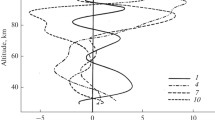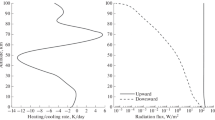Abstract
The calculations of volume intensity profiles of the Earth’s nightglow of the Chamberlain and Herzberg I bands of molecular oxygen are given. The calculations of glow intensities of the Chamberlain and Herzberg I bands are compared with the experimental data obtained from the Discovery Space Shuttle (STS-53) and from the EbertFastie spectrograph (Kitt Peak National Observatory, USA, Arizona). It is shown that the best agreement between the calculation results and experimental data is observed when correcting the quantum yields of the vibrational levels A'3Δu and \({{{\text{A}}}^{3}}\Sigma _{{\text{u}}}^{ + }\) of the molecular oxygen states under triple collisions.





Similar content being viewed by others
REFERENCES
Antonenko, O.V. and Kirillov, A.S., Modeling the Earth’s nightglow spectrum for systems of bands emitted at spontaneous transitions between different states of electronically excited oxygen molecules, Bull. Russ. Acad. Sci.: Phys., 2021, vol. 85, no. 3, pp. 310–314.
Bates, D.R., Oxygen band system transition arrays, Planet. Space Sci., 1989, vol. 37, no. 7, pp. 881–887.
Broadfoot, A.L. and Bellaire, P.J., Jr., Bridging the gap between ground-based and space-based observations of the night airglow, J. Geophys. Res., 1999, vol. 104, no. A8, pp. 17127–17138.
Broadfoot, A.L. and Hunten, D.M., Excitation of N2 band systems in aurora, Can. J. Phys., 1964, vol. 42, no. 6, pp. 1212–1230.
Broadfoot, A.L. and Kendall, K.R., The airglow spectrum, 3100–10,000 a, J. Geophys. Res., 1968, vol. 73, no. 1, pp. 426–428.
Kirillov, A.S., Electronic kinetics of main atmospheric components in high-latitude lower thermosphere and mesosphere, Ann. Geophys., 2010, vol. 28, no. 1, pp. 181–192.
Kirillov, A.S., Model of vibrational level populations of Herzberg states of oxygen molecules at heights of the lower thermosphere and mesosphere, Geomagn. Aeron. (Engl. Transl.), 2012, vol. 52, no. 2, pp. 242–247.
Kirillov, A.S., The calculation of quenching rate coefficients of O2 Herzberg states in collisions with CO2, CO, N2, O2 molecules, Chem. Phys. Lett., 2014, vol. 592, pp. 103–108.
Krasnopolsky, V.A., Excitation of the oxygen nightglow on the terrestrial planets, Planet. Space Sci., 2011, vol. 59, no. 8, pp. 754–766.
Perminov, V.I., Semenov, A.I., Shefov, N.N., Deactivation of hydroxyl molecule vibrational states by atomic and molecular oxygen in the mesopause region, Geomagn. Aeron. (Engl. Transl.), 1998, vol. 38, no. 6, pp. 761–764.
Semenov, A.I. and Shefov, N.N., An empirical model of nocturnal variations in the 557.7-nm emission of atomic oxygen: 1. Intensity, Geomagn. Aeron. (Engl. Transl.), 1997, vol. 37, no. 2, pp. 215–221.
Semenov, A.I. and Shefov, N.N., Variations in the temperature and atomic-oxygen concentration of the mesopause–lower thermosphere region according to variations in solar activity, Geomagn. Aeron. (Engl. Transl.), 1999, vol. 39, no. 4, pp. 484–487.
Semenov, A.I., Pertsev, N.N., Shefov, N.N., Perminov, V.I., and Bakanas, V.V., Calculation of the vertical profiles of the atmospheric temperature and number density at altitudes of 30–110 km, Geomagn. Aeron. (Engl. Transl.), 2004, vol. 44, no. 6, pp. 773–778.
Shefov, N.N., Semenov, A.I., and Pertsev, N.N., Dependencies of the amplitude of the temperature enhancement maximum and atomic oxygen concentration in the mesopause region on seasons and solar activity level, Phys. Chem. Earth, 2000, vol. 25, nos. 5–6, pp. 537–539.
Shefov, N.N., Semenov, A.I., and Khomich, V.Yu., Izluchenie verkhnei atmosfery – indikator ee struktury i dinamiki (Emission of the Upper Atmosphere as an Indicator of Its Structure and Dynamics), Moscow: GEOS, 2006.
Slanger, T.G. and Copeland, R.A., Energetic oxygen in the upper atmosphere and the laboratory, Chem. Rev., 2003, vol. 103, no. 12, pp. 4731–4765.
Author information
Authors and Affiliations
Corresponding authors
Additional information
Translated by M. Samokhina
Rights and permissions
About this article
Cite this article
Antonenko, O.V., Kirillov, A.S. Modeling the Earth’s Nightglow Intensity of the Chamberlain and Herzberg I Bands and Comparing the Calculation Results with the Experimental Data. Geomagn. Aeron. 62, 614–622 (2022). https://doi.org/10.1134/S001679322204003X
Received:
Revised:
Accepted:
Published:
Issue Date:
DOI: https://doi.org/10.1134/S001679322204003X




